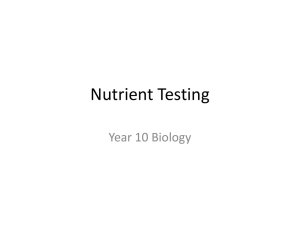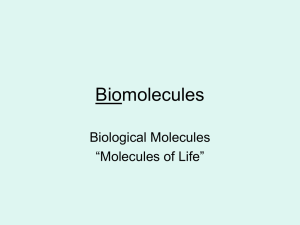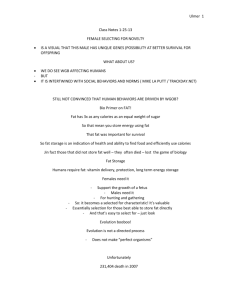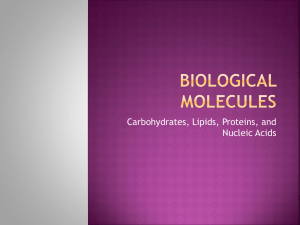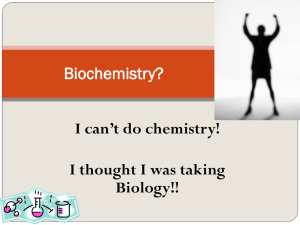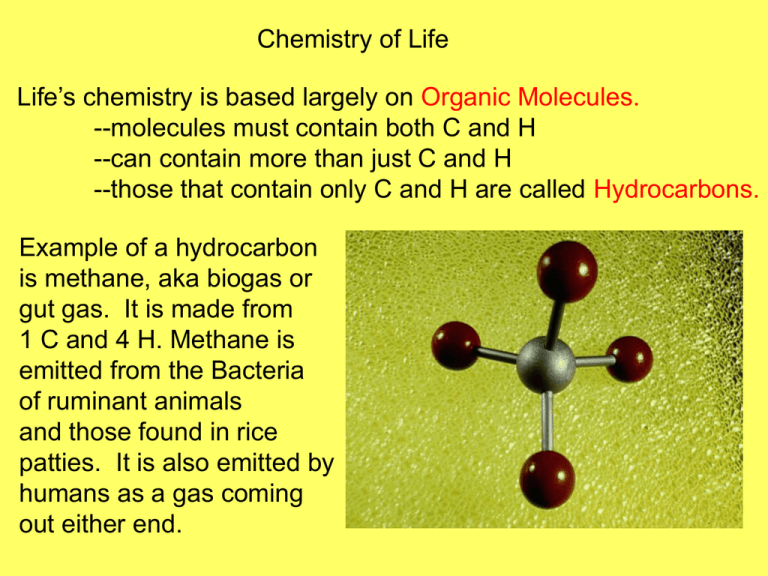
Chemistry of Life
Life’s chemistry is based largely on Organic Molecules.
--molecules must contain both C and H
--can contain more than just C and H
--those that contain only C and H are called Hydrocarbons.
Example of a hydrocarbon
is methane, aka biogas or
gut gas. It is made from
1 C and 4 H. Methane is
emitted from the Bacteria
of ruminant animals
and those found in rice
patties. It is also emitted by
humans as a gas coming
out either end.
Most of the important molecules in living organisms have
long chains of carbon molecules forming a backbone for
other atoms to attach to.
These carbon atoms can also attach to carbon atoms of other
molecules to form very large, or macro molecules.
Dehydration Synthesis:
-used to build large
molecules from small
ones.
-a single water molecule
is removed from the
two large molecules…an
H+ from one and OHfrom the other.
-they join at this point
-this example shows amino
acids joining to form a protein
Molecules can also be broken down. To do this, reverse the
process used during dehydration synthesis…instead of taking
a water molecule away, add one!!
This process is called Hydrolysis and it is used to break a large
molecule into many smaller one that can be used to build with.
4 Major Groups of Macromolecules Play an Important Role in
Living Organisms.
1. Carbohydrates
2. Lipids
3. Proteins
4. Nucleic Acids
Carbohydrates:
-Mainly C, H, and O in a 1:2:1 ratio.
-General chemical formula is (CH2O)n with n = any #
-Source of “quick energy” for the body
-Found in many foods we consume like pasta, bread,
cakes, cookies, pizza, sugared drinks, beer
Monosaccharides = simple sugars
-simplest class of carbs
-sugars such as glucose (blood sugar) and fructose
(fruit sugar)
Disaccharides = two sugars
-two monosaccharides joined by dehydration synthesis
-most common disaccharide is sucrose = glucose + fructose
“table sugar” made from sugar cane or sugar beets.
-lactose = glucose + galactose…”milk sugar” found in
all dairy products. Some people lack the enzyme to help
break down lactose in their body and are called “lactose
intolerant.”
-maltose = glucose + glucose…”malt sugar” found in
malted milk balls, malt for milk shakes, and brews.
Polysaccharides = many sugars
-long chains (100’s to 1000’s) of monosaccharides
Examples:
Starch- plant storage sugar.
-plants make sugars in leaves and transport to storage
area like roots or fruits or grains.
-pastas and breads are considered “high starch” foods
Glycogen- animal storage sugar.
-animals store in liver until needed and
then convert it to glucose
Cellulose- “fiber”
-forms cell walls of plants
-largely indigestible…provides fiber for most
organisms and helps keep them “regular”
-ruminants can digest cellulose because they have an
extra stomach, the “rumen,” which contains
microorganisms that break down the cell walls of
plants. When the plant cells pass into the next
stomach, digestion occurs as normal.
Ruminants
Goats
Cows
and
and
Deer
giraffes
Notice how
large the
rumen is
Chitin = outer shell of insects, crabs, lobster, crayfish, etc.
these organisms lack a skeletal system and use the
chitin shell for support and protection.
When you step on a bug and it goes “crack” you have crushed
some chitin!!
Chitin is non-biodegradable meaning it does not break down in
the ground over time like most parts of organisms.
This characteristic is important in the manufacturing of suturing
thread used to put stitches in you when you cut yourself.
Think about it…it is strong and won’t break down over time
during the healing process so it allows the skin to heal and then
you can remove it.
Next time you get stitches, ask the doctor if he is using the
traditional “cat gut” or if he is using “chitin.”
Lipids:
-mainly C and H. Contain very little O.
-source of long term energy storage for the body
-lipids have 6x as much energy as carbs but are much
harder for the body to break down.
-also serve as protective layers (think whale blubber)
and precursors of larger molecules
-are hydrophobic…meaning they fear water.
Fats—
-class of lipids found in many foods we consume
-consist of one fatty acid and three
glycerols joined by
dehydration synthesis.
(triglyceride)
-see Figure 3.15, pg. 42
-two classes of fats…
Saturated Fats—
-have all C atoms completely covered with H atoms.
The molecule is “saturated” and is not easily broken
down.
-are solids at room temperature. When in fridge, they
become “bricks” and are hard to use
-main source is animal fats such as lard and real butter
-tend to build up in arteries as plaque because they are
not broken down. Lead to “arthrosclerosis” or plugged
arteries.
Heart pumps same
amount of blood
through blocked
artery but works
much harder and
heart attack occurs
Unsaturated Fats—
-C atoms are not completely covered by H atoms. Some
double bonds can readily bond with other atoms to
allow hydrolysis to occur.
-still not good to consume in large amounts
-found mostly in plant products…peanut oil, sunflower
oil, vegetable oil, corn oil, canola oil
-generally liquid at room temperature…will not freeze.
-reindeer in artic have pockets of unsaturated fats in
their hooves to prevent them from freezing
What about Hydrogenated
Vegetable Oil? Where do you
find it at? Is it good for you?
-most “spreadable” butters are plant oils that have been
hydrogenated…
-makes them more aesetic to use at the table but less
healthy for your body.
http://www.ekcsk12.org/faculty/jbuckl
ey/apbio/phospholipid.gif
Waxes—
-protective coverings for plants and animals
-where do we find them?
-what do they protect against?
Phospholipids—
-important components of the cell membrane
-learn more about them in the next unit
Steroids—
-have ring shape instead of
linear shape
-classified as lipids because
they are hydrophobic
http://www.uic.edu/classes/bios/bios100/lecturesf04am/steroid.jpg
-Cholesterol is important to body as part of cell membrane
and ingredient in sex hormones estrogen and testosterone
Anabolic steroids— “not from the body”
-variants of male testosterone.
-build up bone and muscle mass
-cost is great…many side effects…”roid rage” common
-can suffer liver damage
-build manly muscles in women
-reduced testicle size in men
http://symptomsofliverdamage.com/images/l
iver_damage.jpg
Proteins:
-mainly C, H, O, and N
-building blocks are amino acids (20 common aa’s build an
infinite number of proteins)
-protein shape determines function
-seven different classes of proteins do many different jobs
Classes of Proteins:
-structural proteins
used for support…hair and spider webs,
horns and feathers, tendons and ligaments are all strong
-contractile proteins
found in muscles and are like elastic…allow muscle
to expand and contract without losing shape
-transport proteins
found many places to transport materials throughout
the body…hemoglobin is an example and transports
oxygen from your lungs throughout your body
http://drugline.org/img/term/hemoglobin-f-6953_3.jpg
Signal proteins-relay messages from one part of the body to another.
-hormones are a good example…they help start and stop
processes in the body by their release
Storage proteins-store amino acids to be used for development of young
organisms…such as a seed or an egg.
tigrepelvar2.wordpress.com
Defense proteins-antibodies in your immune
system
-each antibody will be
http://images.tutorvista.com/content/immune-system/antigenantibodies-formation.jpeg
specific for a different “bug”
-will only attack what it is programmed to
-flu, tetanus, hepatitis vaccines all have relatively “harmless”
versions of the “bugs” that are introduced into your body to
help build up an antibody army against it so when you come
into contact with the real thing your body is ready to fight!
Enzymes—
-very important class of protein
-govern virtually every system in the body
-speed up chemical reactions without becoming part of the
reaction…thus, one enzyme can speed up thousands of
chemical reactions.
-called “catalysts”
-lower the “activation energy” or the amount of energy
that is needed to start a reaction.
When a protein undergoes a shape change, it loses its ability
to function properly. This is called DENATURING.
These eggs do not have
the same function after
heat is added to them.
I doubt cooked eggs can
produce a baby chick!!
Nucleic Acids:
-information storage molecules
most common are DNA and RNA, ATP
-contain “directions” for building proteins, supply cell energy
DNA-located in the nucleus of the cell
-made up of nucleotides
3 part molecule:
Phosphate
Sugar (2)
Deoxyribose in DNA
Ribose in RNA
Nitrogen Base (4)
Adenine ~ Thymine
Cytosine ~ Guanine
-all genetic information written in 4 letter alphabet
A, T, C, G
RNA-messages carried to cytoplasm, amino acids connected to make
protein by different RNA types.
ATP- located throughout the cell where energy processes take place.
some cells have more ATP than others based on activity.

